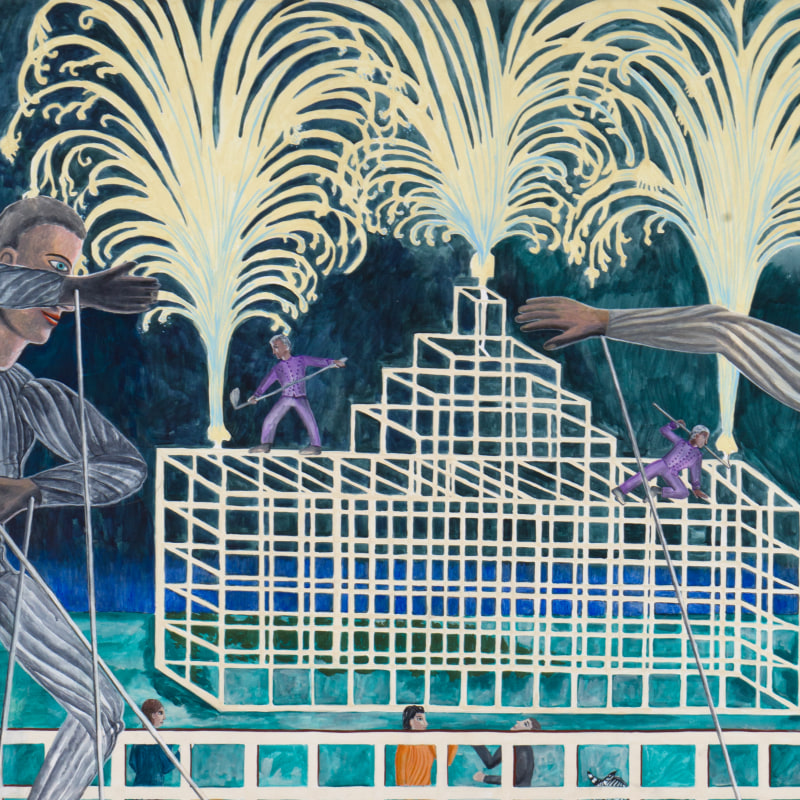The sequence of dioramas that unfold in the folio and accompanying performance depict historical instances in Western society where the creativity of the human mind, and a spirit of curiosity, have been co-opted for industry; significant moments of the past, where ingenuity and poetry have been captured by capital, and mechanised for profit. A group of people gather to admire a beached whale before the scene dissolves to reveal a factory; whale oil lamps light a night shift for workers toiling at benches producing alarm clocks. Two inventors use a mechanism to create an automatic swan. A weaving mill owner marvels at the amusement machine. He appropriates its principles to develop the automatic loom. A bailiff comes to the household of impoverished weavers and reads out a writ of seizure. The folio unfolds and, like a cinematic jump cut, reveals the scenario to be a genre picture being admired in a museum. The picture is reproduced for sale in a gift shop. In the extreme present, where capitalism’s transformation from industrial to emotional labour feels increasingly exploitative, we are privy to a grim genealogy of its rise. Disneyland, Ferris wheels, racetracks and white-water rapid rides populate the scenes with an anachronistic playfulness, juxtaposing processes of disenchantment with a supposedly sublime primitivity typical of historical romanticism. Religious iconography and military drama converge, suggesting human experience is deeply entrenched in both disciplinary and coercive institutional frameworks, and that the museum and its history cannot be separated from such a matrix.
Woe and Awe also provides opportunity for Scherer's ongoing collaboration with musician Tobias Textor, who continues to score the artist’s performances in response to these ideas. The music is developed in parallel to Scherer's work and gains a tonal and visual belonging amongst the characters and scenes on display. Textor has produced a set of bespoke instruments that, through their materiality, reference Scherer's sculptural story-telling device. The music produced with these instruments exhibits a directness, rigor and rigidity that evoke associations with industrial processes. Industriousness is likewise mirrored as mechanical processes have been deployed to trigger multiple sounds and movements simultaneously. Cymbals attached to strings can be played remotely using a foot pedal, bells are triggered using hand pulls and several flutes are connected via a system of tubes. ‘Flam’ percussive techniques, whereby two strokes, one dragged or played earlier than the other, are adopted alongside intentional and accidental polyrhythms that create a shimmering character in the temporal perception. This furthers the physical texture of the sound and there is an emphasis on sonic dissonance that sits alongside the imagery of labour in the performative spectacle of the folio.
Looming above, celestial figures are suspended from the ceiling with wings and hinged bodies. Resembling large pincer-like tools reminiscent of torture devices of the inquisition era, there is a tension in their materiality and form, and their function is rendered ambiguous: are they judging or protecting? Are these sympathetic figures, guiding humanity through their trials and mistakes, or are they angels of mercy – technologies of another malevolent institution, corrupted by power? Elsewhere in the exhibition, paintings elaborate the sense of puppetry at work; fireworks permeate depictions of distressed puppeteers operating pictorial scenes from the margins.
We are invited to speculate on the situations and contexts of the scenes in more detail, while also being reminded we are present in the very site being critiqued. If historically, the museum was able to constitute a public in the image of a national identity – one predicated on colonial power – then Scherer’s work asks what it is constitutive of now. The work is resistant to the idea that art institutions are in any way disciplinary, and instead frames them as places of entertainment that produce a gentle coercion. The space we find art in, far from being impervious to neoliberal ideology and immune to capitalist capture, becomes an unwilling accomplice to its mission. Scherer points to industrialisation, not just as a historic era, but as a metaphor, too. If industrialisation forms a constitutive condition of "romantic" melancholy, Woe and Awe playfully inverts this condition by making melancholy a prerequisite for automation processes.
Agnes Scherer (b. 1985, Lohr am Main, Germany) lives and works in Berlin and Salzburg. She studied painting at the Kunstakademie in Düsseldorf and is currently a professor of Painting at Mozarteum University Salzburg. Scherer has exhibited internationally with recent solo presentations including Ein seltsames Spiel, Kunst Halle Sankt Gallen, St. Gallen (2023); Savoir Vivre, Heidelberger Kunstverein (2023); The Notebook Simulations, Kunstverein für die Rheinlande und Westfalen, Düsseldorf (2021); The Salty Testament, Residency, 1646, The Hague (2020); The Teacher, Cabaret Voltaire, Zürich (2020); The Very Hungry, Horse & Pony, Berlin (2019); Cupid and the Animals, TRAMPS, New York (2018) and Cupid and the Animals, TRAMPS, London (2017). Recent group exhibitions include Atopia I, dacodac, Zurich (2024); Antéfur, CAPC Musée d’art contemporain de Bordeaux (2023); Spirits, Lore Deutz - Atelierhaus Kunstwerk Köln e.V., Cologne (2022); Labor, CAL (Centre d’Archive Laïque), Charleroi (2022); Omnibus - 10 Years of Kinderhook & Caracas, Kinderhook & Caracas, Berlin (2022); and MASKULINITÄTEN, Kunstverein Düsseldorf (2019). Her work is held in various public collections including FRAC Champagne-Ardenne, Reims; Sigg Art Foundation; Moderna Museet, Stockholm; KOLUMBA Museum, Cologne; and Kunsthaus NRW Kornelimünster, Aachen.
